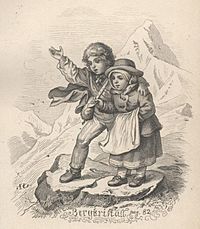Rock Crystal (novella) facts for kids

1853 Ludwig Richter illustration
|
|
| Author | Adalbert Stifter |
|---|---|
| Original title | Bergkristall |
| Language | German |
|
Publication date
|
1845 |
Rock Crystal (its German name is Bergkristall) is a short novel written in 1845. It was created by Adalbert Stifter, an author from Austria. The story is about two children who get lost in a big snowstorm. This happens in the Alps mountains on Christmas Eve.
About Rock Crystal
Rock Crystal is a famous story. It has been enjoyed by many readers for a long time. It shows how strong children can be. It also shows the power of nature.
The Story
The story follows two young children. They live in a small village in the mountains. On Christmas Eve, they go to visit their grandparents. A sudden and fierce snowstorm hits while they are traveling. The children get lost in the deep snow. They must try to survive the cold night. The story describes their struggle. It also shows their hope and courage.
What People Thought
Many famous writers have praised Rock Crystal. Thomas Mann, a well-known author, called Stifter a very special storyteller. He said Stifter was one of the most interesting writers in the world.
Poet W. H. Auden also admired the story. He said it was amazing how Stifter made a simple story so powerful. Auden felt it was a beautiful tale. It showed how people connect with places. It also showed how humans relate to nature.
Author Susan Choi noted that the story's strength comes from avoiding disaster. She said the children survive through many small miracles. This makes the story very gripping.
Hannah Arendt, a famous thinker, called Stifter a "friend of reality." She said he was the best at describing landscapes in literature. This is because he focused on small, real details. He did not just use general ideas.
Translations and Films
Rock Crystal has been translated into English several times. The first English version came out in 1914. Later, in 1945, Elizabeth Mayer and Marianne Moore translated it. This version was re-released in 2001 and 2008.
The story has also been made into movies and TV shows.
- In 1949, it became the film Mountain Crystal.
- In 1954, it was a TV movie called Bergkristall.
- Another TV movie, Bergkristall, came out in 1974.
- In 1999, it was a TV movie called Cristallo di rocca - Una storia di Natale.
- In 2004, a film titled Rock Crystal was released.

